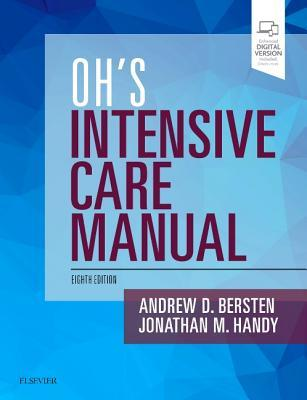Oh’s Intensive Care Manual, 8th edition

Oh’s Intensive Care Manual
8th Edition
Authors: Andrew Bersten Jonathan Handy
Paperback ISBN: 9780702072215
eBook ISBN: 9780702076077
eBook ISBN: 9780702076060
Imprint: Elsevier
Published Date: 24th October 2018
Page Count: 1480
Info/Buy
Tax Exempt Orders
Support Center
Secure Checkout
Personal information is secured with SSL technology.
Free Shipping
Free global shipping
No minimum order.
Description
For nearly 40 years, Oh’s Intensive Care Manual has been the quick reference of choice for ICU physicians at all levels of experience. The revised 8th edition maintains this tradition of excellence, providing fast access to practical information needed every day in today’s intensive care unit. This bestselling manual covers all aspects of intensive care in sufficient detail for daily practice while keeping you up to date with the latest innovations in the field.
View less >
Table of Contents
PART 1 – Organisation Aspects
1 – Design and organisation of intensive care units
2 – Critical care Outreach & rapid response systems
3 – Severity Scoring and Outcome Prediction
4 – Transport of the critically ill patients
5 – Physiotherapy in intensive care
6 – Critical care nursing
7 – Ethics
8 – Common problems after ICU
9 – Clinical information systems
10 – Trials
11 – Palliative care
12 – ICU and the elderly
13 – Team based health care delivery
14 – Genetics and Sepsis
PART 2 – Shock View less >
15 – Overview of shock
16 – Haemodynamic monitoring
17 – Multi-organ dysfunction syndrome
18 – Monitoring oxygenation
19 – Hyperlactatemia in Critical Illness
PART 3 – Acute Coronary Care View less >
20 – Acute cardiac investigations and interventions
21 – Cardiopulmonary resuscitation (including defibrillation)
22 – Cardiac arrhythmias (combine with drugs)
23 – Cardiac pacing
24 – Acute Heart failure and Pulmonary Hypertension
25 – Valvular and congenital heart disease and infective endocarditis
26 – Postoperative cardiac intensive care
27 – Echocardiography in intensive care
PART 4 – Respiratory Failure View less >
28 – Oxygen therapy
29 – Airway management and acute airway obstruction
30 – Acute respiratory failure in chronic obstructive pulmonary disease
31 – Mechanical ventilator support
32 – Humidifiers and inhalation therapy
33 – Acute respiratory distress syndrome include fat embolism
34 – Pulmonary embolism
35 – Acute severe asthma
36 – Pneumonia
37 – Noninvasive ventilation
38 – Respiratory monitoring
39 – Chest imaging
40 – Ultrasound in the ICU
41 – ECMO
PART 5 – Gastroenterological Emergencies View less >
42 – Acute gastrointestinal bleeding
43 – Acute pancreatitis
44 – Hepatic failure
45 – Abdominal Surgical Catastrophes
46 – Implications of solid tumours for Intensive Care
PART 6 – Acute Renal Failure View less >
47 – Acute Kidney Injury
48 – Renal Replacement Therapy
PART 7 – Neurological Disorders View less >
49 – Disorders of consciousness
50 – Status epilepticus
51 – Acute cerebrovascular complications
52 – Cerebral protection
53 – Brain death
54 – Meningitis and encephalomyelitis
55 – Tetanus
56 – Delirium
57 – ICU acquired weakness
58 – Neuromuscular disorders
PART 8 – Endocrine Disorders View less >
59 – Diabetic emergencies
60 – Diabetes insipidus and other polyuric syndromes
61 – Thyroid emergencies
62 – Adrenocortical insufficiency
63 – Acute calcium disorders
PART 9 – Obstetric Emergencies View less >
64 – Preeclampsia and eclampsia
65 – Obstetric emergencies
66 – Severe cardiac disease in pregnancy
PART 10 – Infections and Immune Disorders View less >
67 – Anaphylaxis
68 – Host defence and immunodeficiency
69 – HIV and AIDS
70 – Sepsis and Septic shock
71 – Nosocomial infections
72 – Severe soft tissue infections
73 – Fungal infection
74 – Principles of antibiotic use in the ICU
75 – Tropical diseases
PART 11 – Severe and Multiple Trauma View less >
76 – Severe and multiple injuries
77 – Severe head injuries
78 – Faciomaxillary and upper airway injuries
79 – Chest injuries
80 – Spinal injuries
81 – Abdominal and pelvic injuries
PART 12 – Environmental Injuries View less >
82 – Submersion
83 – Burns
84 – Thermal disorders
85 – Electrical safety and injuries
86 – Envenomation
87 – Blast and ballistic trauma
88 – Bioterrorism
PART 13 – Pharmacologic Considerations View less >
89 – Pharmacokinetics, pharmacodynamics and drug monitoring in acute illness
90 – Poisoning and drug intoxication
91 – Sedation and pain management in intensive care
92 – Vasopressors and inotropes
93 – Vasodilators and antihypertensives
PART 14 – Metabolic Homeostasis View less >
94 – Acid-base balance and disorders
95 – Fluid and electrolyte therapy
96 – Enteral and parenteral nutrition
PART 15 – Haematological Management View less >
97 – Blood transfusion
98 – Colloids and blood products
99 – Plasmapheresis, therapeutic plasma exchange and intravenous immunoglobulin therapy
100 – Haemostatic failure
101 – Haematological malignancy
PART 16 – Transplantation View less >
102 – Organ donation
103 – Liver transplantation
104 – Heart and lung transplantation
PART 17 – Paediatric Intensive Care View less >
105 – The critically ill child
106 – Upper airway obstruction in children
107 – Acute respiratory failure in children
108 – Paediatric fluid and electrolyte therapy
109 – Sedation and analgesia in children
110 – Shock and cardiac disease in children
111 – Neurological emergencies in children
112 – Paediatric trauma
113 – Treatment limitation and organ procurement
114 – Paediatric poisoning and envenomation
115 – Paediatric cardiopulmonary resuscitation

